Katelyn Buxton's Blog, page 5
July 1, 2017
Irish Names – Female
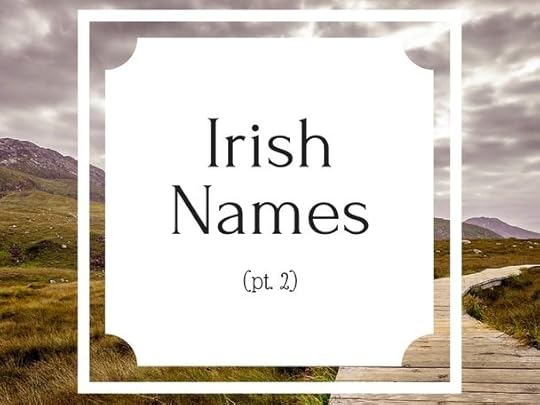 In my
In my Although Irish names are really cool and full of history, I've also made lists of
A
Aideen – jealousy
Aignéis – chaste
Ailbhe – white
Aileen – ?
Ailís – noble; kind; sort; type
Áine – radiance
Aislin – dream; vision
Aisling – dream; vision
Alastríona – defending men; help
Aoife – beauty
Aran – name of the Aran Islands of the west coast of Ireland
Ashling – dream; vision
B
Bébhionn – fair lady
Bébinn – fair lady
Bedelia – exalted one
Bevin – fair lady
Biddy – exalted one
Bláithín – little flower
Breda – exalted one
Bríd – exalted one
Bridget – exalted one
Bridie – exalted one
Brigid – exalted one
Brogan – shoe
Brónach – sorrow C
Cáit – pure
Caitlín – pure
Caitria – pure
Caitríona – pure
Caoileann – slender; fair
Caoimhe – beautiful; gentle; kind
Carey – descendent of Ciardha; Ciardha means black
Casey – descendent of Cathasach; Cathasach means vigilant
Cathleen – pure
Catrina – pure
Ciannait – ancient
Ciara – black
D
Dáiríne – fruitful
Damhnait – fawn; stag; ox
Darina – fruitful
Deirdre – ?
Delma – ?
Derval – daughter of Fál; or daughter of a poet
Dervla - daughter of Fál; or daughter of a poet
Doireann – sullen; tempestuous
Dymphna – fawn; stag; ox
E
Éabha – form of Eve; to breathe; to live
Eadan – jealousy
Éadaoin – jealousy
Eavan – beautiful sheen
Edna – kernel; grain
Eibhlín – ?
Eileen – ?
Eilís – my God is an oath; my God is abundance; or noble; kind; sort; type
Éimhear – swift
Eireen – peace
Eithna – kernel; grain
Elva – white
Emer – swift
Ena – kernel; grain
Ennis – name of a town in Ireland
Enya – kernel; grain
Étaín – jealousy
Ethne – kernel; grain
Etna – kernel; grain
F
Feidelm – ?
Fidelma – ?
Finley – white warrior
Finnuala – white shoulder
Fíona – vine
Fionnuala – white shoulder
Flann – red
Flannán – red
G
Gobnait – little smith
Gormlaith – blue; illustrious; princess; lady
Gráinne – grain
Grania – grain
H
Honora – honor
I
Íde – thirst
Isibéal – my God is an oath; my God is abundance
Ita – thirst
Iúile – form of Julia
K
Kathleen – pure
Keavy – beautiful; gentle; kind
Keelan – slender; fair
Keeva – beautiful; gentle; kind
Kelly – bright-headed; or war; strife; or church
Kennedy – descendent of Cennétig; Cennétig means armored head; misshapen head
Kiera – black
L
Léan – torch; moon
Líadáin – grey lady
Líadan – grey lady
Líle – lily flower
M
Madailéin – form of Magdalene; Magdalene means from Magdala
Maeve – intoxicating
Máire – form of Mary
Mairenn – variant of Máirín
Máirín – Irish diminutive form of Mary
Maura – anglicized version of Máire; also, great
Maureen – anglicized version of Máirín
Mave – intoxicating
Moira – anglicized version of Máire; also, fate; destiny
Móirín – great
Mór – great
Morna – festive
Muirenn – sea; fair; white; or festive
Muirgel – bright sea
Muirgen – born of the sea
Muirín – born of the sea
Muriel – bright sea
Murna – festive
Murphy – descendent of Murchadh; Murchadh means sea warrior
Myrna – festive
N
Nainsí – form of Nancy
Naomh – holy
Neasa – ?
Nessa – ?
Neve – bright
Nóirín – ?
Nora – ?
Noreen – ?
Nuala – white shoulder
O
Odharnait – little pale green one
Onóra – honor
Oona – lamb
Órfhlaith – golden princess
Orla – golden princess
Órlaith – golden princess
Orna – little pale green one
Q
Quinn – descendent of Conn; Conn means chief
R
Raghnailt – advice; battle; counsel
Ráichéal – ewe sheep
Rathnait – grace; prosperity
Reagan – descendent of Riagán; Riagán means impulsive
Ríona – queen; or pure
Róis – rose flower; also fame; kind; sort; type
Róisín – rose flower; also fame; kind; sort; type
Rosheen – rose flower; also fame; kind; sort; type
S
Sadb – sweet; goodly
Saibh – sweet; goodly
Saoirse – freedom
Saraid – excellent
Shea – admirable; hawk-like
Sheila – blind
Shevon – anglicized form of Siobhán
Sibéal – God is my oath; my God is abundance
Síle – blind
Síne – indirect feminine form of John; YAHWEH is gracious
Siobhán – indirect feminine form of John; YAHWEH is gracious
Siofra – elf; sprite
Síomha – good peace
Sive – sweet; goodly
Sláine – health
Sorcha – radiant
T
Talulla – abundance; princess
Toiréasa – possibly summer
Treasa – strength; possibly summer
U
Úna – lamb
Names taken from Behind the Name.
Published on July 01, 2017 06:00
June 15, 2017
Irish Names – Male
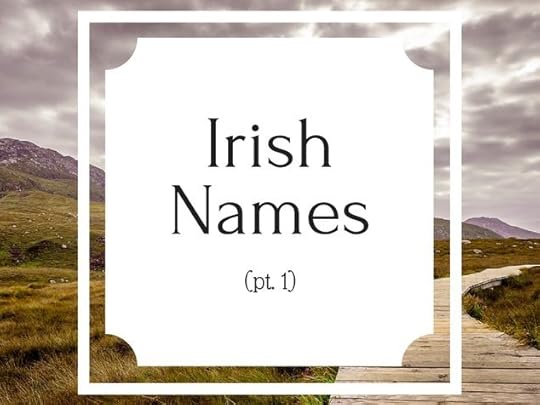 Today's blog post is a list of Irish names for writing purposes! Those who know me from this blog or from following my Twitter know I have a bit of a thing for names, and since names are something we writers have to delve in to from time to time, I thought I'd make a list on a purely writerly site. (After all, visiting baby-name websites can get a little... well... awkward from time to time). Previously, I've made lists of
Today's blog post is a list of Irish names for writing purposes! Those who know me from this blog or from following my Twitter know I have a bit of a thing for names, and since names are something we writers have to delve in to from time to time, I thought I'd make a list on a purely writerly site. (After all, visiting baby-name websites can get a little... well... awkward from time to time). Previously, I've made lists of Next up: the Irish. This list only contains male names, but the next post will provide some for your lady characters as well. Irish names have a unique flavor all their own, steeped in history, so I hope you'll give this list a skim! (Who knows, you might find the one)!
A
Abbán – little abbot
Aidan – fire
Ailill – elf
Ailín – little rock; handsome
Aindréas – manly; masculine
Alaois – form of Aloysius; famous war; battle
Alastar – defending men; help
Alby – white
Angus – one strength; force; energy
Anraí – home ruler
Aodh – fire
Aran – name of the Aran Islands off the west coast of Ireland
Ardal – high valor
B
Barrie – fair hair
Berach – sharp
Brádach – large-chested
Bradán – salmon
Bran – raven
Braonán – rain; moisture; drop
Brendan – prince
Brennan – descendant of Braonán
Brian – hill; high; noble
Brogan – shoe C
Cadogan – glory in battle; honor
Cainneach – handsome
Caolán – slender
Caomh – beautiful; gentle; kind
Carey – descendent of Ciardha
Casey – descendent of Cathasach
Cathair – battle man
Cathal – battle; rule
Cathán – battle
Cathasach – vigilant
Cennétig – armored head; misshapen head
Christie – bearing Christ
Cian – ancient
Cianán – diminutive of Cian; ancient
Ciar – black
Ciardha – black
Cillian – church
Cillín – variant of Cillian
Clancy – son of Flannchadh; red warrior
Cody – descendent of Cuidightheach; helpful
Cóemgein – kind; gentle; handsome
Coilean – whelp; young dog
Colin – whelp; young dog
Colm – variant of Colum
Colmán – diminutive of Colm
Colum – dove
Conall – strong wolf
Conan – little wolf; little hound
Conn – chief
Connor – dog lover; wolf lover
Conrí – wolf king
Cormac – raven; wheel; son
Críostóir – bearing Christ
Cuán – little wolf; little hound
D
Dáire – fruitful; fertile
Dáithí – swift
Dálach – assembly
Daley - descendant of Dálach; assembly
Damhán – fawn; stag; ox
Dara – oak tree
Declan – ?
Derry – without envy
Devin – fawn; stag; ox
Domnall – ruler of the world
Dónal – ruler of the world
Donovan – descendent of Donndubhán; brown; dark
Doran – descendant of Deoradhán; exile; wanderer
Doyle – descendant of Deoradhán; dark stranger
Driscoll – descendent of the messenger
Dubhán – dark; black
E
Eachann – brown horse
Éamon – wealth; fortune; protection
Éanna – bird-like
Edan – fire
Éimhín – swift; prompt
Einrí – form of Henry; home ruler
Énna – bird-like
Ennis – from the name of a town in Ireland
Eoin – form of John; YAHWEH is gracious
Erskine – projecting height
F
Faolán – little wolf
Fearchar – dear man
Fearghall – man of valor
Fearghas – man of vigor
Fechín – little raven
Felim – beauty; ever good
Fergal – man of valor
Fergus – man of vigor
Fillin – little wolf
Finbarr – fair hair
Finley – white warrior
Finnán – white; fair
Finnian – white
Fintan – white fire; white bull
Fionn – white; fair
Flann – red
Flannán – red
G
Gallagher – descendent of Gallchobhar; stranger; help
Garvan – little rough one
Gearalt – rule of the spear
Gilroy – son of the red-haired servant; son of the king’s servant
Gobán – little smith
Grádaigh – noble
Grady – descendant of Grádaigh
Gréagóir – watchful; alert
H
Heber – ?
I
Íomhar – yew; bow; warrior
Ionatán – form of Jonathan; YAHWEH has given
Ivor – yew; bow; warrior
K
Kane – battle
Keane – ancient
Keefe – descendant of Caomh
Keegan – descendant of Aodhagán; fire
Keelan – slender; fair
Keenan – ancient
Kelan – slender
Kelly – bright-headed; war; strife; church
Kennedy – descendent of Cennétig
Kieran – black
Killian – church
Kyran – black
L
Leary – calf herder
Liam – will; desire; helmet; protection
Lochlann – Irish form of Lachlan, a nickname for a person born in Norway
Lonán – little blackbird
Lorcán – little fierce one
M
Mághnus – great
Mahon – bear
Mainchín – little monk
Maitiú – form of Matthew; gift of YAWHEH
Mannix – little monk
Manus – great
Mathúin – bear
Mellan – lightning
Mícheál – form of Michael; who is like God?
Muiris – dark-skinned
Murdoch – lord
Murphy – descendent of Murchadh; sea; warrior
N
Naoise – ?
Naomhán – little saint
Neil – champion; cloud
Nevan – little saint
Niall – champion; cloud
Ninian – ?
Nolan – descendent of Nuallán
Nuallán – noble; famous
O
Odhrán – little pale green one
Oisín – little deer
Orrin – little pale green one
Osheen – little deer
Owen – born from the yew tree
P
Patrick – nobleman
Phelan – little wolf
Phelim – beauty; ever good
Pól – form of Paul; small; humble
Q
Quinn – descendent of Conn
R
Raghnall – advice; counsel; power; ruler
Reagan – descendent of Riagán
Réamann – advice; protector
Redmond – advice; protector
Riagán – impulsive
Rían – little king
Riordan – little poet king
Rónán – little seal
Rórdán – little poet king
Rorie – red; king
Ryan – little king
S
Sé – admirable; hawk-like
Seachlann – second
Séamus – form of James; supplanter
Seán – form of John; YAHWEH is gracious
Senán – little old person
Sorley – summer traveler
Sweeney – well-going
T
Teague – poet
Tiarnán – little lord
Tierney – lord
Torin – chief
U
Uilliam – will; desire; helmet; protection
Uinseann – to conquer
Ultán – of Ulster, which is a region in the north of Ireland
Names taken from Behind the Name.
Published on June 15, 2017 06:00
June 1, 2017
Killing Characters
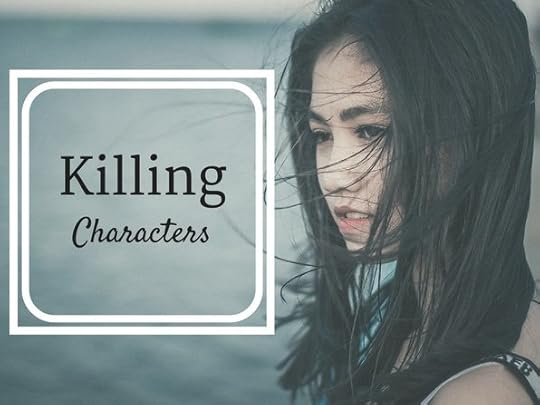 Killing characters. It’s something both reader and writer alike have a love/hate relationship with. Personally, I love it when a character dies—I revel in the sadness, the “what-just-happened,” the emotion more informally known as feels. But at the same time, it has to be done right, and since I just published Healing Scars, Warriors of Aralan #7, I thought now would be an opportune time to write about this subject, because Healing Scars opens almost immediately with a character’s death. (I won’t say who, though… you’ll have to find out by reading it yourself). *writer’s wink*
Killing characters. It’s something both reader and writer alike have a love/hate relationship with. Personally, I love it when a character dies—I revel in the sadness, the “what-just-happened,” the emotion more informally known as feels. But at the same time, it has to be done right, and since I just published Healing Scars, Warriors of Aralan #7, I thought now would be an opportune time to write about this subject, because Healing Scars opens almost immediately with a character’s death. (I won’t say who, though… you’ll have to find out by reading it yourself). *writer’s wink*So, here’s a little list to think about as we move forward.
1.) First of all, is the death necessary? Killing characters just for the sake of it never helped anybody.
2.) This may sound a little macabre, but research the kind of death your character is going to experience. If you're not entirely sure what you're talking about, it'll show.
3.) And don’t forget to think about the aftermath of killing a character. In real life, people who lose loved ones don’t just pick up and move on right away—take time for the grieving process. #1: Is the character’s death necessary?
Let’s go back—way back—to the very moment when this character was born in your imagination. Why? For a very simple reason. Create the character to die, and the death will be easier. This single thought was a breakthrough for me as a writer. Before I realized this, I thought I could write along, quite happily, until the time came for a death. Then I’d pick a character to die, and they’d be no more.
The problem with this mentality is that by the time I decided to kill a character, I had become too attached to the character in question, and couldn’t do it. Not to mention the fact that I had to figure out how to move forward without the skill set of the character that died. If you create them to die, you’ll be prepared. You’ll know it’s coming. The plot will move forward just fine without them, not to mention the fact that you’ll be able to provide any foreshadowing that’s necessary.
Also, whether or not the death is necessary depends greatly on what you’re writing. Fantasy writers like myself must almost certainly be prepared to kill a character or two from time to time, because fantasy often includes fighting. A romance? Maybe not so much, depending on the plot.
#2: Research the death your character dies.
Why? A lot of times we writers subconsciously refer back to what we’ve seen on TV, and sometimes the TV exaggerates the effect of injuries or diseases. (I know, shocker). Just take the time to research before you write, and later your readers will thank you.
#3: Don’t forget the aftermath of the death.
This encompasses everything from grief, to figuring out how to go on without what that character offers to the plot. If you’ve planned for all of this, it won’t be a problem. (Remember? Create them to die, and the death will be easier).
The idea of writing grief might be a daunting one,* but if anyone is left alive at the end of the story, there’s probably going to be at least one character that mourns the loss. (Provided we're not talking about the villain here—although there might be someone that cares there, too). Just be honest. Write with your whole heart. That’s all the reader can ask.
As for figuring out how to move forward with this gaping hole in your book’s cast, if you knew it was coming, this problem should resolve itself automatically.
And what about the "feels" aspect? I've heard it said that to make a character's death sadder, you need to write smaller. Don't write about what everyone else in the vicinity is feeling—write about what one character is feeling (the victim, the victim's best friend, etc). Focus on a tiny bit, and write it well. Did the dying character have unfulfilled goals? Mention them. It's even sadder if they're not ready to go—if they fight the end.
These are just some things I’ve learned while writing character deaths for the Warriors of Aralan series. An antagonist's death may not fit very well into what I've said here, but I hope these tips will help you as much as they’ve helped me!
* I understand that there are some of you for which the grief of losing a loved one is still too near, and that's okay. Wait as long as you need to before writing these scenes.
Published on June 01, 2017 06:00
May 15, 2017
Excerpt from Healing Scars
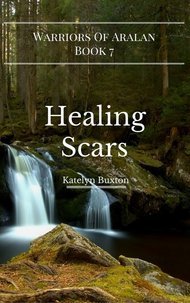 I've been talking about "Warriors of Aralan #7" for a while now, and so I'm really excited to reveal three important things about it with this post:
I've been talking about "Warriors of Aralan #7" for a while now, and so I'm really excited to reveal three important things about it with this post: 1.) It has a name: Healing Scars.
2.) The cover! (That book-shaped image just to the left of this text).
3.) And a little tidbit of of the story itself in the form of an excerpt.
I'm hoping to release Healing Scars to Amazon later this month, but until then, here's the excerpt. Enjoy!
------------------------------
Though Mercy was perplexing, a lazy day at her special fishing hole turned out to be a pleasant experience. Each of the three children caught several fish, and Ben kept two of his biggest to bring home. About midway through the afternoon, Benjamin suggested swimming.
Impulsive as Mercy was, she eyed the choppy water doubtfully. “I don’t know if it’s safe.”
“Can’t you swim?” Ben asked, a challenge in his voice.
Mercy stood up indignantly. “Of course I can! It’s just that daddy said to never swim near waterfalls because they can push you under.”
Had Kenan been quicker to speak, no one might have gotten wet that day. As it was, Ben found his tongue long before his friend. “That’s not a very big waterfall,” he said scornfully, gesturing at it. It was true—but it wasn’t a very small one either. And then, without further ado, Ben flung himself into the water.
Mercy dithered on the bank for a moment, setting her fishing pole and line straight, and then she followed with a much smaller and less enthusiastic jump.
Benjamin broke the surface again, flinging his wet hair out of the way with a roguish grin. “Come on Kenan, the water feels good.”
Kenan sat down slowly and dangled his legs in the water, shaking his head. “I think I’m all right here.” It wasn’t that he couldn’t swim—he and Ben had spent many summer afternoons doing just that—it was that, like Mercy, he wasn’t entirely sure swimming there was a good idea.
Just then Mercy came up gasping for air, and Ben burst out laughing. Her dark brown hair usually formed a perfect frizz all the way around her head, mirroring the spunk of the girl it belonged to, but when wet it went completely flat, draping, soaked, around her head and neck. “What?” she asked, frowning.
Benjamin splashed her. “You look like a drowned rat!” he exclaimed, laughing so hard he went under.
When he came up again, it was to a skillful jet of water in his face. “I do not!” Mercy retorted crossly.
“Do too!”
“Do not!”
“Do too!”
Soon Mercy was pursuing Ben around the foaming pool, and both hurled insults freely. Though perhaps Benjamin’s motives hadn’t been entirely pure when he called Mercy a drowned rat, their insult war became a light-hearted competition.
Kenan stood up and watched their progress anxiously. “Aren’t you getting a little close to the waterf—oh!” Suddenly Ben felt himself tugged under with all the power and might of hundreds of gallons of water, and the breath was crushed from his lungs. Bubbles escaped from his mouth, and his wildly kicking feet collided painfully with a sharp rock on the bottom. He could see nothing but murky dim greenness, and panic gripped his heart when he could hear nothing but the dull roar of the waterfall churning the water into thousands of fine white bubbles all around. For one horrible second everything went still and quiet, and even though his lungs still screamed for oxygen he no longer cared. But suddenly he was propelled upwards by the current and broke the surface with a mighty gasping of air. Light, sound, and colors all came as a shock to his senses, and he felt Kenan’s hands grip his arms and haul him out onto the bank
Everything still seemed far-off and misty, like a rapidly-fading dream, but the sensation of Kenan patting his cheek and yelling at him brought him out of it. He blinked groggily at his friend, who looked caught halfway between anger and fear. “Benjamin, you fool! I thought you were getting too close to the waterfall, but—” he stopped suddenly, and an expression of horror crossed his face. He turned slowly to look at the pool, and then back at Ben. His face was ghostly white. “Mercy hasn’t come up yet.”
Benjamin sat up immediately, the sudden motion causing him to retch water and wince as he rediscovered the injury to his foot. He was surprised when he saw the sheer amount of blood oozing from the wound. He tried to ignore it, though the breath caught in his throat. “Mercy was pulled under too?” he asked, voice hoarse.
Kenan was up and pacing back and forth on the bank like a caged lion as he scanned the water. “Oh this is bad! So, so bad!” He whirled on Ben suddenly, furious. “Yes, she was pulled under! You both went under at the same time!”
Ben groaned and lay back, covering his eyes with his hands. Perhaps now would be a good time to pray to his father’s God. No sooner had the thought crossed his mind than he heard Kenan doing that exact thing. “Lord, help us,” Kenan groaned. “We’re just children—Ben didn’t mean to drown Mercy.”
Almost instantly one outspread hand—then another—and finally Mercy’s head—broke the surface, and if Ben had made a loud noise sucking oxygen into his lungs, she was even louder. Kenan put both hands on his head as if he couldn’t believe what he was seeing, and she paddled feebly to shore, spitting water. “No, you’re right,” she grinned weakly at Kenan as he took her hand to pull her out, “There aren’t any giant eels down there.”
As she flopped on the bank alongside Ben, chest heaving for air, they compared battle wounds, and she sat up. Of course Benjamin had a sizeable cut on his left foot from the rock it had encountered underwater, but Mercy had her fair share of scrapes and bruises to show for the experience. After they finished, Mercy threw herself back down on the bank, arms outspread in dramatic celebration. “We’re alive!”
“At least until our parents kill us,” Ben muttered.
Published on May 15, 2017 00:00
May 1, 2017
Answers to April's #authorconfession and #WIPjoy Part 2
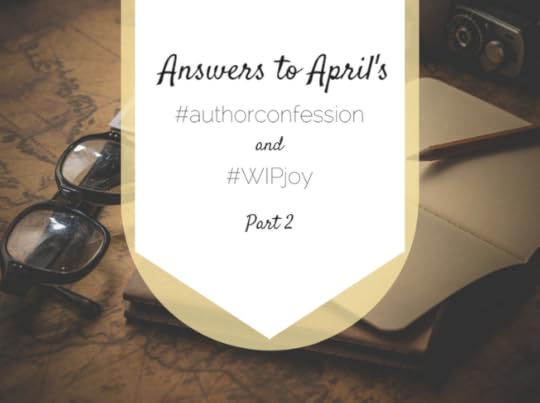 During the last month, I've had the pleasure of joining in a couple of writing-centered hashtag games on Twitter. The first, called #authorconfession, is hosted by @_JM_Sullivan, and the second, called #WIPjoy, by @simmeringmind. Every day participants in either #authorconfession or #WIPjoy are provided with a new question about their work-in-progress or themselves, and they're a lot of fun, besides having really helped me think about my characters in new ways.
During the last month, I've had the pleasure of joining in a couple of writing-centered hashtag games on Twitter. The first, called #authorconfession, is hosted by @_JM_Sullivan, and the second, called #WIPjoy, by @simmeringmind. Every day participants in either #authorconfession or #WIPjoy are provided with a new question about their work-in-progress or themselves, and they're a lot of fun, besides having really helped me think about my characters in new ways.Most of the above-mentioned answers come from Warriors of Aralan #7, and therefore offer a sneak peek into the lives of Allister and his son Ben before they hit Amazon later this year. But be warned! Spoilers are contained in the following answers.
Day Sixteen
#authorconfession Question: Where would your main character find an Easter Egg?
Answer: Right when he [Ben] opened his eyes in the morning. Allister would leave it there, and leave several more hidden elsewhere.
#WIPjoy Question: How would you best describe your setting?
Answer: Fantasy, leaning towards a more historically accurate Dark Ages, in a made-up country of my own invention. ;)
Day Seventeen
#authorconfession Question: What's your main character's "deadly sin"?
Answer: Ben's “deadly sin” would be greed. It's what drives him to lie and steal—he's greedy for the thrill, not just stuff.
#WIPjoy Question: What was the first thing you knew about your story's world/setting?
Answer: Oh wow. *reaches five years back in the brain archives* Probably something boring like the fact that Aralan is forested.
Day Eighteen
#authorconfession Question: A book isn't complete without...
Answer: A book isn't complete without three-dimensional characters. I want to see their struggles—not just their reactions.
#WIPjoy Question: Story location you'd most like to visit?
Answer: Aralan's castle... because, I mean... it's a castle! 'Nuff said.
Day Nineteen
#authorconfession Question: What's your main character's favorite song?
Answer: I don't think Ben has a favorite song. He hasn't heard enough music to know, living in Aralan.
#WIPjoy Question: Share a line that displays your world.
Answer: A description of the field that holds the famous archery range of Linfort, in summertime: Heat waves shimmered and danced across the field, and the whine of summertime insects never stopped.
Day Twenty
#authorconfession Question: Find a GIF to describe your work-in-progress.
Answer: You'll have to click here to see the GIF.
#WIPjoy Question: Three unique elements of your world.
Answer: That's hard, because I'm not sure anyone can write an idea that hasn't been thought of by someone else before. But here goes...
1.) The chief weapon of one of my main characters (Allister), is throwing knives.
2.) Warriors of Aralan #7 centers around a single father (single due to his wife's untimely death), raising a son, not a daughter.
3.) Aralan is home to the famed "Tournament of Warriors," which is much like the Olympics, except with only four disciplines: one for Aralan's archers, one for Aralan's sword-wielders, one for Aralan's spear-carriers, and one for Aralan's axe-bearers. Day Twenty-One
#authorconfession Question: Your main character wouldn't be caught dead...
Answer: Ben wouldn't be caught dead... crying for real. He's a 9-year-old. A big kid. ;)
#WIPjoy Question: Do you have a history for your world?
Answer: The short answer? Yes. By Josiah's time it's over 300 years of history. At Ben's, just a little over 200.
Day Twenty-Two
#authorconfession Question: Tell a secret about yourself!
Answer: Well let's see... I own a corn snake named Hydrangea. :)
#WIPjoy question: If you could bring one element from your story into reality, what would it be?
Answer: Probably the Tournament of Warriors. Better than the Olympics (because, annual) and holds competitions for warrior disciplines.
Day Twenty-Three
#authorconfession Question: What would give your villain the "upper hand"?
Answer: If Ben would cooperate. Hearst is after Allister, Ben's father, and almost convinced Ben to betray him. Almost.
#WIPjoy Question: Share a book, blog, or piece of advice that has really helped your writing.
Answer: “Don't tell me the moon is shining; show me the glint of light on broken glass.” - Anton Chekhov
Day Twenty-Four
#authorconfession Question: Who's your main character's favorite superhero?
Answer: Well I can't really answer that since my story takes place about as far from the superhero culture as is possible. xD
#WIPjoy Question: Are you a plotter, pantser, or hybrid? What do you enjoy most about that style?
Answer: I'm a plotting pantser. :P I find that if I have a general idea where I'm going with it, the book turns out better.
Day Twenty-Five
#authorconfession Question: What reasons do you DNF [Do Not Finish] books?
Answer: Either I don't like what I see (as far as content or just bad writing), or can't see the plot going anywhere.
#WIPjoy Question: Link day! Tell us about your writings!
Answer: I write clean YA fantasy, featuring real people with real problems. My eBooks can be found on Amazon.
Day Twenty-Six
#authorconfession Question: Yellow light! Does your main character brake?
Answer: LOL, if Ben's driving, we've got a problem. His father? Yes. Yes, Allister would brake. (Assuming he ever lived in a world that had cars).
#WIPjoy Question: Share a line that makes you smile.
Answer: Context: Allister, Ben's father, was trying to teach the girl how to use throwing knives, and she and Ben don't get along. :P
"Allister's sharp glance of frustration would have stopped most children from saying more, but Ben wasn't most children. When the girl stuck her tongue out at him, he promptly returned the favor."
Day Twenty-Seven
#authorconfession Question: What's your main character's favorite pastime?
Answer: Ben's favorite pastime is... causing mischief. ;P But he also likes to go fishing.
#WIPjoy Question: Share something encouraging that you believe every author needs to hear.
Answer: Don't give up—you're a writer if you keep writing in spite of everything. First drafts are bound to be messy, and that's okay.
Day Twenty-Eight
#authorconfession Question: Word count report!
Answer: Finished and partially edited, Warriors of Aralan #7 currently stands at 32,181 words.
#WIPjoy Question: Share some authors whose books your readers may also like!
Answer: The Redwall series by Brian Jacques, the Viking Quest series by Lois Walfrid Johnson, and the Kingdom series by Chuck Black.
Day Twenty-Nine
#authorconfession Question: What's your main character's greatest regret?
Answer: Good question. Ben's greatest regret would be running back to the battle and getting his father almost killed.
#WIPjoy Question: What do you post most, and where?
Answer: Twitter is my favorite social media. I tweet links to my blog posts, writer's humor, writing tips, and things about Jesus. :)
Day Thirty
#authorconfession Question: Don't be shy! Give us your best pitch!
Answer: A mischievous, troublemaking 9-year-old goes on a downhill slide after finding out he's the reason he has no mother.
#WIPjoy Question: Explain your work-in-progress in ten words or less!
Answer: *cough cough* SPOILER ALERT *cough cough cough*
• Ava dies.
• Allister cries.
• Ben lies.
Now forget everything I just said! (Meaning my very concise, spoiler-riddled answer to #WIPjoy day 30).
And that wraps up April's #authorconfession and #WIPjoy! If you want more, you can head back to Part 1 and read the answers for days 1-16, or you can find me on Twitter and follow the writing and reading-related content I tweet there. :) Thanks for reading!
Published on May 01, 2017 00:00
April 15, 2017
Answers to April's #authorconfession and #WIPjoy Part 1
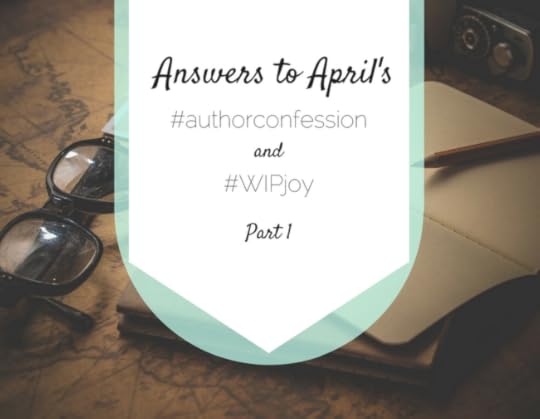 For the last fifteen days I’ve been participating in a couple of writerly hashtag Q & A games on Twitter—namely, #authorconfession (hosted by @_JM_Sullivan) and #WIPjoy (hosted by @simmeringmind). Each day participants are provided with a new question about their work-in-progress to answer, and it’s a lot of fun both to answer the questions, and hear what other authors have to say as well.
For the last fifteen days I’ve been participating in a couple of writerly hashtag Q & A games on Twitter—namely, #authorconfession (hosted by @_JM_Sullivan) and #WIPjoy (hosted by @simmeringmind). Each day participants are provided with a new question about their work-in-progress to answer, and it’s a lot of fun both to answer the questions, and hear what other authors have to say as well.So for today’s blog post, I thought I’d treat the last fifteen days of author confessions and work-in-progress joys like the book Q & A’s they are, and list the questions and my answers, which correspond to Warriors of Aralan 7, the next of the series to be published, and its brand-new protagonist Ben. (Spoilers may be contained).
Day One
#authorconfession Question: Is your main character a prankster?
Answer: Ben could be, but the story happens at a time in his life when he's too troubled for things like that.
#WIPjoy Question: Introduce your work-in-progress!
Answer: This is the story of a troubled 9-year-old named Ben and his path to reconciliation with his father and the death of his mother.
Day Two
#authorconfession Question: Are you doing Camp NaNoWriMo? Why?
Answer: I'm not doing Camp NaNo unfortunately. I have more than one editing project to attend to.
#WIPjoy Question: Describe your main character for us.
Answer: Ben is a mischievous, troublemaking 9-year-old with big blue eyes rimmed in dark lashes, auburn hair, and an irresistible smile. (I found this image on Pinterest and thought it looked almost exactly like an older Ben).
Day Three
#authorconfession Question: Three words a character uses to describe the main character.
Answer: Ben's friend Mercy described him as a cheat, a thief and a liar once. :P (He did deserve it though).
#WIPjoy Question: Share a visual that goes with your work-in-progress.
Answer: Ben plays marbles! (Although the clothes are all wrong in this pic since I write fantasy).
Day Four
#authorconfession Question: What’s your main character’s favorite school subject?
Answer: Ben's favorite subject in school is avoiding going to school. ;)
#WIPjoy Question: Share a song that inspires you for this story.
Answer: Just Be Held by Casting Crowns. It applies more to Ben's father, Allister, but it's part of the story.
Day Five
#authorconfession Question: Thoughts on bad language in books?
Answer: It isn't necessary. “Cursing is small minds expressing themselves forcefully.” There are ways around it.
#WIPjoy Question: Share a line of description.
Answer: Allister looking on his wife right before she dies. The moment his heart broke.
He turned back to look at Ava, and his expression shattered into a thousand little creases of agony and grief. Day Six
#authorconfession Question: Describe your work-in-progress using only emojis!
Answer: (You'll have to click here since my website doesn't support emojis, haha).
#WIPjoy Question: Name something in your work-in-progress for each of the senses: sight, sound, taste, smell, touch.
Answer: Sight: Throwing knives
Sound: Clamor of battle
Taste: Crusty dried porridge
Smell: Warm, green summer forest
Touch: Cold hands
Day Seven
#authorconfession Question: What's your main character's favorite color?
Answer: I get the feeling that Ben is a blue kinda kid.
#WIPjoy Question: If your story was represented by one item, what would it be?
Answer: Throwing knives. Allister, Ben's father, teaches throwing knife lessons, and Ben wants to learn how to use them so bad.
Day Eight
#authorconfession Question: Finish the sentence: When I write, I...
Answer: When I write I give myself over to the story, and bleed my heart onto the page.
#WIPjoy Question: If you like _____, you'll like my book!
Answer: If you like Jotham's Journey/Tabitha's Travels etc. by Arnold Ytreeide, you'll like Warriors of Aralan Book 7.
Day Nine
#authorconfession Question: Tell a secret about your work-in-progress!
Answer: Well spoiler alert... Ben's mom dies having him, leaving his father, Allister, to raise him alone.
#WIPjoy Question: From the main character: most awkward memory?
Answer: Me: Most awkward memory?
Ben: *squirming* The time I cut off Clare's hair. She was so bossy!
Me: I knew you'd say that.
Day Ten
#authorconfession Question: Tell an important date for your main character. Why?
Answer: Ben: My birthday? 'Cause it was the day I was born, and also the day my mother died.
Me: Wow that was honest.
Ben:
#WIPjoy Question: From the antagonist: happiest memory?
Answer: Hearst: *laughs* The day I found deposits of Pretiosum ore and formulated a plan to become a rich man off of them.
Day Eleven
#authorconfession Question: Which element best describes your main character?
Answer: The element that best fits Ben is water. Cold, pure, rushing and dashing recklessly... sometimes dangerous.
#WIPjoy Question: From a side character: what's the most pain (physical or emotional) that you've been in?
Answer: Me: Okay Mercy, you're up.
Mercy: *fidgeting* When Ben's father was injured and we thought he might die. For Ben.
Day Twelve
#authorconfession Question: Has your main character ever had their heart broken?
Answer: Oh yeah. If you're a character of mine your heart is going to be broken some time or other. *evil author laugh*
#WIPjoy Question: Share a line from the main character about food.
Answer: Way more than a line (more like an entire scene) but it involves food. Ben doesn't really talk about food that much.
Allister sat his son down in one of the only two chairs in the cottage, then seated himself at the other one. He leaned forward on the table, clasping his hands as he looked at the nine-year-old at his side. It still seemed only yesterday he had had to face his fears of being a father. “Ben,” he began, slowly, deliberately, “I need you to be really honest with me right now.”
Benjamin was fast losing the hope that his little acts would get him anywhere. He again appeared sullen as he picked at a splinter on the table.
With nothing else to do, Allister took his son’s silence as an agreement to cooperate. “Recently you have been getting into a lot of trouble,” he sighed. “But you haven’t always been that way. Can you tell me why?”
Allister caught a glimmer of blue as Ben glanced at him. “I dunno,” he muttered stubbornly.
“I asked you to be honest. That’s not honest.”
Again, Benjamin glanced at him, then, almost longingly, at the blue sky and sunshine just outside the window in front of him. “Clare annoys me,” he repeated.
Allister was having a difficult time staying patient, and his tone grew irritated. “And that’s another thing. You know you’re not allowed to touch my knives. How did you get one? I’ve been wearing them all day.”
Ben reached over and slid the top knife out with a self-satisfied grin. “Like this!”
Allister snatched the knife back. “Ben!” he exclaimed, “Stop! Do you remember why you’re not allowed to touch weapons?”
Ben sat back and heaved a long-suffering sigh. “Because I’m a ‘hazard to my own health.’”
Allister sheathed the knife grimly. “Exactly. You’re always covered in bruises and scrapes. I don’t think you need any help hurting yourself.”
Ben looked as if he might like to debate that point, but his father ended the conversation when he realized that he was getting nowhere.
Allister pointed at the small cauldron over the fire, which he had forgotten to clean after breakfast that morning. “As punishment for cutting Clare’s hair off, you have to scrub that, and then stay close to my side for three days.”
Benjamin’s face registered pure disgust when he looked inside the cauldron, which was a mess of baked-on porridge scraps. “Do I have to?” he whined.
Allister turned his chair around so he could watch Ben’s progress, and put his hands behind his head. “You wouldn’t have to if you had behaved yourself today. Now hurry, I have to teach knife-throwing lessons in an hour.”
Day Thirteen
#authorconfession Question: Fast-forward 2o years... what's your main character up to?
Answer: Fast-forward 20 years? Ha, Ben's chasin' around a whole passel o' children, and very happily married to Mercy.
#WIPjoy Question: From your antagonist: what's your deepest regret?
Answer: Me: Deepest regret?
Hearst:
Me:
H: Not dodging that last arrow.
M: *snorts* *whispers behind WIPjoy Q. paper* He's dead so...
Day Fourteen
#authorconfession Question: Is your main character religious?
Answer: No. No one in this book is “religious.” But Ben's father does have a real relationship with God as His child.
#WIPjoy Question: From a side character: what gives you joy in life?
Answer: Me: Okay Mercy, what gives you joy?
Mercy: *looks thoughtful* Everything!
Me: Yes... yes, you are a happy child.
Day Fifteen
#authorconfession Question: What's your main-character's favorite holiday?
Answer: Ben's favorite holiday is his birthday. He's a 9-year-old boy after all.
#WIPjoy Question: From the main character: your favorite music?
Answer: Ben's favorite music? I don't think he's heard enough to form an opinion. Aralan is not very arts-centered.
And that's it for this blog post! In part two I'll post the rest of my answers, or you can find me on Twitter and read each day's Q & A's as I tweet them. Thanks for reading!
Published on April 15, 2017 00:00
April 1, 2017
Creative Writing Prompts IV
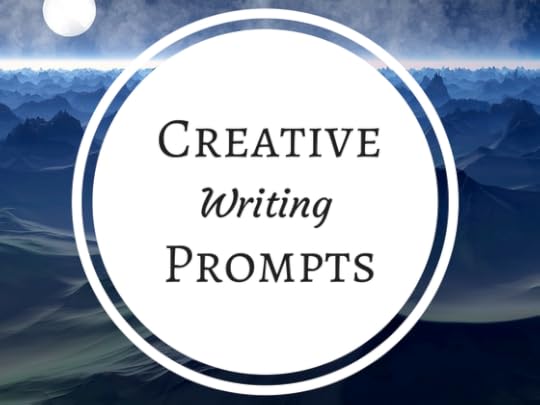 Sometimes there's nothing like a good old-fashioned writing prompt to get those creative juices flowing again. After all, we all have those times where we hit the wall of our creativity, and even though the story is ours, can't think of a way to answer to the simple question, "What happens next?" Hopefully, these prompts will help remedy that.
Sometimes there's nothing like a good old-fashioned writing prompt to get those creative juices flowing again. After all, we all have those times where we hit the wall of our creativity, and even though the story is ours, can't think of a way to answer to the simple question, "What happens next?" Hopefully, these prompts will help remedy that.1.) He still remembered the first time he tasted oxygen.
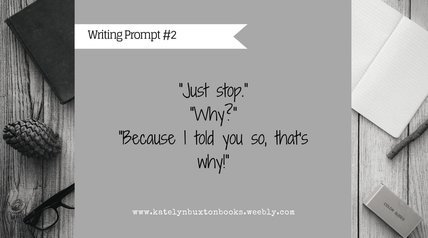 3.) Being turned into something else by magic is always a punishment. What if someone wanted to be turned into an animal? What would make someone that desperate?
3.) Being turned into something else by magic is always a punishment. What if someone wanted to be turned into an animal? What would make someone that desperate? 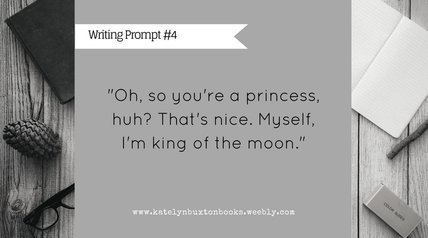 5.) A world where parents can choose one personality trait for each of their children, based on the meanings of the first name they choose. (And for a special fee can add a middle name for an extra bonus).
5.) A world where parents can choose one personality trait for each of their children, based on the meanings of the first name they choose. (And for a special fee can add a middle name for an extra bonus). 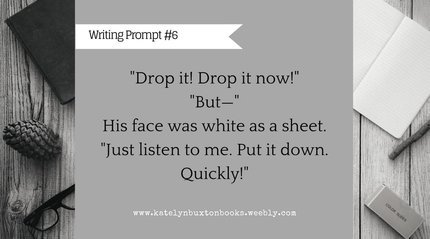 7.) "I'm not yet eighteen, and I've seen it all—love and hate, peace and war, joy and pain—but nothing has prepared me for the consequences of tinkering with time."
7.) "I'm not yet eighteen, and I've seen it all—love and hate, peace and war, joy and pain—but nothing has prepared me for the consequences of tinkering with time." 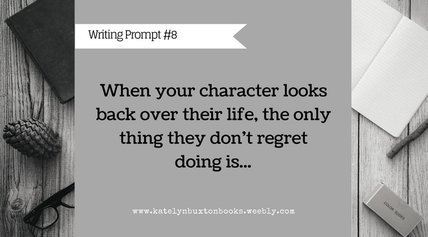 9.) "Hey, wait, you can't just kill my parents like that!"
9.) "Hey, wait, you can't just kill my parents like that!""I'm the author. Can, and am."
"Great, now I'm an orphan. Haven't seen that done before."
"But you have a rich uncle that will take you in and—"
"Ooh, even better. Let me guess, he has a mansion?"
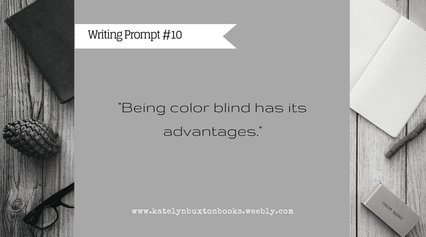 I hope these were useful to you, whether they helped keep a current story going, or inspire a new one, but if they didn't...
I hope these were useful to you, whether they helped keep a current story going, or inspire a new one, but if they didn't...Writing Prompts I
Writing Prompts II
Writing Prompts III
My Writing Prompts board on Pinterest
Published on April 01, 2017 00:00
March 15, 2017
Archery for Writers Part 4/4: The Compound Bow
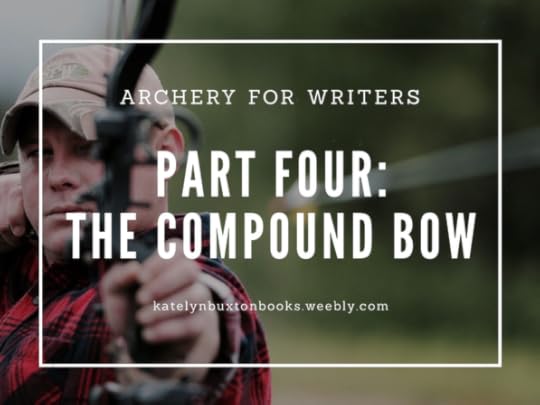 Here we are, on the last post of the four-part Archery for Writers series. It’s been a pleasure both as an archer and a writer to let the writing world know a little more about the sport, and today we’re going to talk about the compound bow. It is possibly the most complicated type of bow to manufacture, and doesn’t show up much in pop culture, but it is by far the most popular with today’s archers.
Here we are, on the last post of the four-part Archery for Writers series. It’s been a pleasure both as an archer and a writer to let the writing world know a little more about the sport, and today we’re going to talk about the compound bow. It is possibly the most complicated type of bow to manufacture, and doesn’t show up much in pop culture, but it is by far the most popular with today’s archers.(Again, before we get started, if you ever find yourself confused by archery terminology, you can refer back to part one of this series. At the bottom of the page is a quick glossary of words and definitions).
Origins: Though the compound bow is far and away the most commonly-shot bow amongst both hunters and those who only shoot for sport, it a relatively recent invention. In the 1960s a man by the name of Holless Wilbur Allen¹ invented the compound bow after much trial and error by sawing off the ends of a recurve bow and attaching offset pulleys (cams) to the new tips and fixing it up with an extra-long string. He wanted to create a bow that propelled arrows through the air faster, because the bows available at the time shot arrows relatively slowly, giving deer plenty of time to jump out of the way.
When he had finally succeeded in his mission to create a bow that shot arrows faster, therefore inventing what we now know as the compound bow, he filed a patent for it on June 23rd 1966. In 1969 the patent was granted, and only ten years later two-thirds of the bow models on the market were compound². Unfortunately, he died in 1979³. Description: In my previous post I described the recurve bow as being different than any other bow because it has tips that curve away from the archer. Well, the compound bow is even more different than any other bow, because it doesn’t have any tips! Instead, the limbs of a compound bow terminate in cams, which are the secret to increased arrow velocity, as well as another important advancement: a resting point.
No other bow in history has a resting point, the point at which the force needed to draw the string partially lets off and allows the archer to hold the string comfortably for an extended period of time. It is also packs a much bigger punch in a much smaller package, even more so than the recurve bow. Compound bows today are even adjustable, meaning beginning archers can set their bow at a low draw weight, and work up from there.
It is truly the greatest thing since sliced bread. (Which was apparently invented in 1928⁴ in case you were curious).
Today the risers of compound bows are made of aluminum, magnesium alloy, or carbon fiber to make them as rigid as possible⁵, while the limbs are made of many different composite materials to make them flexible, yet not break under the huge amount of stored energy put on them at full draw⁶.
As far as color goes, compound bows come pretty much in any color imaginable. The original Genesis bow⁷ (which are what I learned to shoot on) is especially vibrant. Camo is also very popular, even in pink. For length, many compounds run about 32-34 inches axle-to-axle now,⁸ but the Genesis bow I mentioned above is 35½.
Why These Bows are the Greatest Thing Since Sliced Bread: I’ve pretty much already outlined it. They’re short. They’re fast. They have a resting point. They have adjustable draw weights. Plus (and I haven’t gone here yet) they can also have a lot of “helps” tacked on. These are optional devices such as sights, silencers, and stabilizers. When I learned to shoot on the original Genesis bow, I shot it bare, meaning I had an arrow rest and wore a finger glove to protect my oh-so-tender fingertips, but that was it.
When I was fifteen I had dreams of one day becoming a bow-hunter (a dream I still haven’t gotten around to, by the way), so I got another bow. It was still a compound, but it was shorter, lighter, and could adjust to the 40-pound minimum draw weight needed for deer hunting (the Genesis only went up to 20). It was a Bear Apprentice II bow⁹, and came with a whole assortment of things attached that I’d never used before. Two sights—a front sight and a peep sight—a whisker biscuit (a different kind of arrow rest), an on-bow quiver, and D-loop. Since it had a D-loop, that meant I could no longer shoot with my fingers, so I began using a mechanical release. Needless to say, I had to learn to shoot all over again, but it was worth it, because I became more accurate.
Shooting: Well, how do you shoot a bow with all that extra stuff? Pretty much the same way I described in part one of this series, with the exception that, if you (or your character) uses a mechanical release there are no fingers touching the string. I use a trigger release, which has a strap that wraps around my wrist and buckles into place, and a short metal rod that projects just past the end of my closed fist on the palm side. It has small “jaws” on the end that grab the D-loop, as well as a trigger with which I set it off when I’m ready. (If that made no sense, you can get the full run-down on different archery releases here). Also, mechanical archery releases are always worn on the drawing hand, which is determined by whether you are right or left-eye dominant.
For aiming I have a three-pin sight, which means that I can aim with spot-on accuracy (provided I do all the steps right) at three different distances. It also means I can be reasonably accurate at any point in between, and these distances can be adjusted to whatever the archer wants. To aim I look through the peep sight, which is basically just a circle of plastic set in the fibers of the bowstring, line it up with the circle surrounding the pin sight set on the riser of my bow, put the right pin on the target, and exhale as I pull the trigger on my release.
Other kinds of releases, such as handle or finger releases, “go off” when the archer reaches a certain tension, or point, when drawing back. These are better for target shooting than hunting, for obvious reasons. And then there are automatic releases that go off on a timer... which are also better for target practice than hunting. (Neither of these sound like a very good idea to me, even for target practice, but I had to mention them since they exist).
The Arrows: Modern arrows are typically made of aluminum, carbon, or a combination of aluminum and carbon,¹⁰ and are tipped with metal, whether it is only a field tip (used just for target practice) or a broadhead (used for hunting). Most arrows give archers the ability to switch tips out, and so change them if they wish. The same with nocks, most of which are plastic and come in a variety of colors. Fletchings are also very colorful since they are no longer feathers, but are instead made of synthetic materials.
Other Facts:
1.) Modern arrows are actually much more complicated than just what they’re made of. Depending on the individual archer’s draw length, how heavy a draw weight they’re shooting, and whether or not the archer is hunting or just target practicing, things change¹¹.
2.) The let-off that Holless Wilbur Allen achieved with his first compound bow was 15%¹². Modern compound usually bows let off 65-75%¹³ of the original draw eight.
3.) The compact size of compound bows makes them great for hunting, because in a brushy area the short length keeps it from getting caught on things as easily as the other two bow types we've discussed previously.
And that’s concludes my Archery for Writers series. I hope that you’ve enjoyed it, and found it helpful towards writerly ends! If you have anything to say, fire away in the comments section below, or visit the resources I’ve listed.
Archery for Writers Part 1: How to Shoot
Archery for Writers Part 2: The Longbow
Archery for Writers Part 3: The Recurve Bow
-------------------------------------------------------
¹, ², ³, ¹² Archery Hall of Fame – Holless Wilbur Allen
⁴ Wikipedia – Sliced Bread
⁵, ⁶ History of Archery – Facts About Compound Bows
⁷ Genesis Archery – Original Genesis (Please be aware that I am not trying to sell you anything, just show you what I’m talking about).
⁸ Realtree – Finger Shooting Compounds
⁹ Best Compound Bow Source – Bear Archery II Review (And I'm still not trying to sell you anything)…
¹⁰ Shooting Time – Parts of a Compound Bow/Other Archery Terms
¹¹ Best Compound Bow Source – How to Choose Arrows for a Compound Bow
¹³ ESDF – The Compound Bow - What You Need to Know
Published on March 15, 2017 12:15
March 1, 2017
Archery for Writers Part 3/4: The Recurve Bow
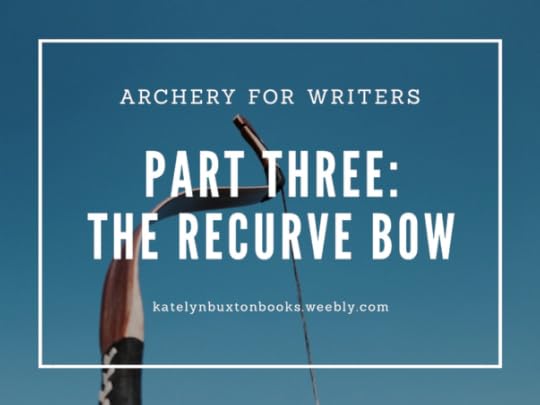 With today’s post, we tackle the recurve bow, which has been around in some form since the days of ancient Egypt. The recurve bow is therefore considered “traditional” by many of today’s archers, but it is by no means simple in construction when compared to the longbow we discussed last time. Even though both bows were very popular during the middle ages, the recurve bow was mainly used by the Mongols, while the Europeans preferred the longbow because of its simplicity and ease of creation.
With today’s post, we tackle the recurve bow, which has been around in some form since the days of ancient Egypt. The recurve bow is therefore considered “traditional” by many of today’s archers, but it is by no means simple in construction when compared to the longbow we discussed last time. Even though both bows were very popular during the middle ages, the recurve bow was mainly used by the Mongols, while the Europeans preferred the longbow because of its simplicity and ease of creation.(If you find yourself confused at any point because of archer lingo, you can refer back to part one of this series, which has a small glossary of archery terms and definitions at the bottom of the page).
Origins: As stated above, the recurve bow has been around for a very long time. Though it was used in ancient Egypt, it was often imported from other parts of the Middle East instead of being made there in the land of the Pharaohs¹. The Mongols², however, were really the ones that perfected the recurve bow, and were frighteningly accurate with it. (Well, frightening if you’re not a Mongol). Description: The recurve bow is different than any other bow, because the tips curve away from the archer, oftentimes even when fully drawn. When not strung, the recurve bow may even bend so far in the opposite direction so as to form a crescent or even a nearly-complete circle. They are also composite, made that way even in the time of the Mongols.
When making a recurve bow, the Mongols started with³ a wooden backbone or spine typically made of birch, because it’s resilient and was readily available. The total length of this wooden frame was about five feet. On the curved tips, where the impact of the string was the greatest when released (the side towards the archer) they attached flattened pieces of sheep’s horn which added an extra “pop” to the arrow as it was released. They then covered the bow with a layer of birch bark and sinew to keep out moisture, and held the whole thing together with fish glue.
After all this, they wrapped it tightly in ropes and put it in a form where it was allowed to dry at room temperature for a year or more. When it was done drying, it was strung with stretched and twisted animal hide. What animal, you say? Horse was preferred. (My apologies, horse-lovers). Made this way⁴, a Mongolian recurve bow would last for many years, even with frequent shooting.
The difference between ancient recurve bows and modern ones is mainly the materials used for construction. Though the limbs are sometimes still made of wood, they are also made of other layered materials, such as fiberglass or carbon. The riser is actually separate most of the time, and can also be made of wood or carbon, but also magnesium or aluminum alloy. The string, it is safe to say, is no longer made of horse. Instead, various synthetic fibers have taken over.
Why These Bows Were the Pride of the Mongols: The Old Mongolian Bow had a draw weight of about 100 to 160 pounds, and archers could hit their target at about 350 yards (although there is evidence⁵ that suggests they could and did really shoot much, much further than that. Possibly even up to 585 yards).
Also, the recurve nature of these bows means that they pack a bigger punch in a smaller package, which in turn means they can be shot from horseback much more easily than, say, a longbow. (Think about it—wielding a six-foot longbow on horseback would be difficult).
Shooting: I described basic shooting techniques in part one of this series, but the Mongols had such an interesting way of shooting their recurves that I thought it was worth noting. I’ll quote Cold Siberia⁶ on this one. They proceeded as normal, up until the release stage: “Since this bow has immense power, the Mongols have to use a special technique to hold the string during the drawing of the bow and before the arrow is released. The technique is as follows: The string is held by the thumb, since this is the strongest finger. Still, it is not easy to hold 166 pounds* comfortably. Thus, the thumb is supported with the index finger curling around, placed atop the outermost joint, exactly at the base of the nail. The other fingers are also curled, forming a fist. Even so, this is not enough. Hence, the Mongols use a Reshafim – Projectiles
Published on March 01, 2017 00:00
February 15, 2017
Archery for Writers Part 2/4: The Longbow
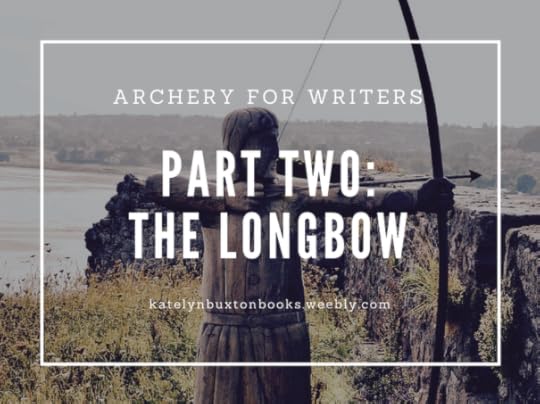 Today’s blog post is part two of the Archery for Writers series! In my last post I outlined the basics of shooting a bow in general—this time we’re going to learn about the longbow! Fantasy writers listen up, this was one of the most feared weapons in the middle ages, and was used by all the classes. It’s also important to note that the recurve bow was also around during that time, but the longbow was much more powerful and easy to manufacture, making it the weapon of choice.
Today’s blog post is part two of the Archery for Writers series! In my last post I outlined the basics of shooting a bow in general—this time we’re going to learn about the longbow! Fantasy writers listen up, this was one of the most feared weapons in the middle ages, and was used by all the classes. It’s also important to note that the recurve bow was also around during that time, but the longbow was much more powerful and easy to manufacture, making it the weapon of choice.(If you have any questions about archery terms while reading through this, feel free to refer to part one of the Archery for Writers series. At the bottom of the page is a mini glossary of words that should help clear up anything I say in Archer-ese).
Origins: One of the earliest mentions of the longbow was in AD 633¹ in the hands of the Welsh, when Offrid, son of king Edwin of Northumbria was shot by one. However, it was very popular throughout the middle ages, and forms of the longbow have been used all over the world for a very long time. Description: The traditional longbow is very simple, about 6 feet long, made of a single piece of yew wood and strung with linen or hemp, although it was sometimes made of other kinds of wood if yew wasn’t available, such as wych elm or ash². Modern longbows are often composite, meaning they are made of several strips of different woods laminated together. A skilled bowyer (a person that makes bows) can make a traditional longbow from seasoned wood in a matter of a couple hours. Inexperienced bowyers can still turn one out in a few days.
Why These Simple Bows are Just So Terrifying: First of all, I’ll offer an extract³ from the writings of a historian called Gerald of Wales in the 12th century: “…[I]n the war against the Welsh, one of the men of arms was struck by an arrow shot at him by a Welshman. It went right through his thigh, high up, where it was protected inside and outside the leg by his iron chausses, and then through the skirt of his leather tunic; next it penetrated that part of the saddle which is called the alva or seat; and finally it lodged in his horse, driving so deep that it killed the animal.”
It not only went through the man’s leg (which was armored), but it went through the saddle and deep enough into the horse he was riding to kill it. Granted, this passage doesn’t tell us how close he was to the archer that shot him, but he might have been pretty far away.
Reconstructions of longbow artifacts from the medieval period suggest that some had a draw weight of up to 160 or 180 pounds⁴. To put that in perspective, I shoot a compound bow that is currently set at about 45 pounds, which is enough to legally shoot a deer where I live (my dad shoots a 50-pound bow). The point is, these archers were pulling crazy draw weights! It’s no wonder that skeletons of medieval archers showed deformed limbs and bone spurs⁵. With draw weights that high, it is estimated that they had a range of 180 to 249 yards⁶, and were very effective at penetration (as you might have noticed in the historical passage above). I've heard it said that longbows could penetrate a knight in armor at 200 yards, though I’ve forgotten the source.
Shooting: I outlined basic shooting techniques in the previous blog post, but it’s important to note that longbows do not have a resting point, which means that the further the string is drawn back, the harder and harder it is to hold. With a nearly 200-pound draw weight, these archers were shooting on instinct. There was no time to aim—they merely drew, looking at the point they wanted to hit, and released. To shoot by instinct like this requires lots of practice to be accurate, but I imagine a person wouldn’t have to be very accurate to be effective in a battle. If an army is charging towards you, and you shoot in their general direction, you’re bound to hit something. (Kind of a macabre observation, but hey, this is for writing, right)? *writer’s wink*
The Arrows: There were many different kinds of arrowheads⁷ used in the medieval period with longbows, but they can be divided into two categories: barbed and non-barbed. Generally speaking, barbed arrows were used for hunting, and non-barbed arrows were used for piercing different kinds of armor in battle. The arrow shaft was made of various types of wood, and usually fletched with goose feathers⁸.
Other Facts:
1.) A skilled longbowman can shoot up to 12 arrows per minute⁸. (Think of them like the machine gun of the middle ages).
2.) When not in use, longbows (and recurves) are kept unstrung. If they're strung all the time, they get permanently bent out of shape and lose the "spring" that makes them work.
3.) Bowstrings made of hemp become stretchy when wet, so medieval archers often stowed them inside their hats to keep them dry.
4.) Getting snapped will probably just leave your character with a painful bruise, but if the draw weight is high enough, bowstrings are capable of taking the skin off the arm.
5.) King Edward III’s declaration of 1363⁹ made it clear he wanted the common people to practice archery whenever possible: “Whereas the people of our realm, rich and poor alike, were accustomed formerly in their games to practise archery – whence by God’s help, it is well known that high honour and profit came to our realm, and no small advantage to ourselves in our warlike enterprises…that every man in the same country, if he be able-bodied, shall, upon holidays, make use, in his games, of bows and arrows…and so learn and practise archery.”
6.) Firing multiple arrows at once is basically just a really cool myth¹⁰. Two can be done, but three, not so much. Plus, in a scenario like a battle it would take way too much time to get multiple arrows nocked correctly, as well as adding the consequence of less accuracy and the fact that dividing the power of the string between each arrow automatically makes their range shorter and weaker. It's a lot more practical to just shoot one at a time, as fast as you can (see fact #1).
7.) Even though I just got through telling you that archers in the middle ages drew extremely heavy draw weights, that doesn't mean all of them did, so don't be afraid to give your characters bows with much lighter poundage.
I hope this blog post has helped you learn a little more about the longbow! I’ve done my best to cite the places I got most of my information, so that you can visit them as well and learn even more. Archery is a huge sport—too big to fit in one blog post—but I tried to condense it down into a format that provides the necessary information without having to wade through all the other details first. Next up: the recurve bow!
¹, ⁴, ⁵, ⁶ EDinformatics – Longbow
² Bow International – Native Bow Woods
³, ⁹ Realm of History – 10 Things You Should Know about the English Longbowman
⁷ Longbow Archers – Arrowheads
⁸ History for Kids – Medieval Arrows
¹⁰ Worldbuilding – Realism of a Multi-Arrow Bow
Published on February 15, 2017 06:00



